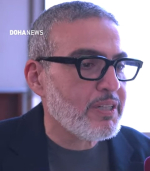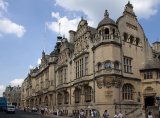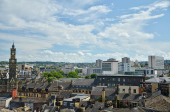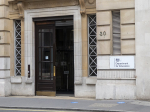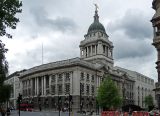
City Hall has today published new data showing dramatic improvements in London’s air quality across the capital since 2016, confirming that measures implemented by the Mayor have helped
transform the capital’s air.
There are two main air pollutants of concern in London, based on their impact on human health: nitrogen dioxide (NO2) and fine particulate matter (PM2.5). Poor air quality stunts the growth of children’s lungs and worsens chronic illnesses, such as asthma, lung and heart disease.
While significant progress has been made, with a substantial reduction in the number of Londoners living in areas exceeding legal limits for NO2, tens of thousands of Londoners still breathe illegally polluted air and all Londoners live in areas exceeding the recently updated World Health Organization (WHO) recommended guideline for PM2.5, which is much tighter than the national legal standard. Research shows that those exposed to the worst air pollution are more likely to be deprived Londoners and from Black, Asian and minority ethnic communities.
The data reveals that:
- In 2019, 84 per cent of major roads* in London met the legal limit for NO2, compared to 46 per cent in 2016 and just 37 per cent in 2013.
- There has been a significant reduction – approximately 22 percent - in NO2across the whole of Greater London from 2016 to 2019 with notable improvement in areas meeting the legal limit for NO2 in 2019. These improvements will continue with the recent expansion of the world’s first Ultra Low Emission Zone up to the North and South Circular roads.
- Huge progress has been made on London’s ‘red routes’ with 70 per cent of the Transport for London Road Network (TLRN) meeting the legal limit for NO2 in 2019, increased from 29 per cent in 2016 and just 21 per cent in 2013. London's red routes make up five per cent of London’s roads, but carry up to 30 per cent of the city's traffic.
- The PM2.5 concentration maps show that there was a 19 per cent reduction in PM2.5 across the whole of the city since 2016 with many parts of outer London meeting the WHO interim guideline of 10µgm-3 for the first time. Nearly 1.2 million Londoners now live in areas meeting the WHO interim guideline of 10 µgm-3 in 2019. It had been previously estimated that no Londoners were living in areas meeting this target in 2016.
There is still much more work to do before London meets legal and safe pollution limits and all Londoners can breathe clean air. Sixteen per cent of major roads in London still exceed the legal limits for NO2 and of an estimated 575 care homes in the city in 2019, 86 per cent of these facilities were in areas exceeding the WHO interim PM2.5 guideline of 10µgm-3. All were in areas exceeding the WHO PM2.5 guideline of 5µgm-3. This underlines the importance of the expanded Ultra Low Emission Zone (ULEZ) to the North and South Circular roads as nearly four million people live within the recently expanded zone.
Last week a new City Hall report showed there are now 47,000 fewer polluting vehicles being driven in the new zone on an average weekday day with 92 per cent of vehicles in the zone now meeting the ULEZ emissions standards – up from 39 per cent in February 2017**. There were also 11,000 fewer vehicles seen in the zone at all.
The success of the world-leading ULEZ and other action taken by the Mayor gives confidence that the expansion of the ULEZ will help deliver wider benefits for London, including saving the NHS around £5 billion and preventing more than one million air pollution related hospital admissions over the next 30 years.***
The fact that such significant progress has been made reducing PM2.5 concentrations – with nearly 1.2 million Londoners now living in areas meeting the WHO interim guideline of 10 µgm-3 in 2019 compared to none in 2016 – adds to the growing consensus that, as a minimum, the interim WHO guideline should be included in the secondary legislation of the Environment Act as a new legally binding target for PM2.5.
This is needed for the protection of people’s health and will also benefit the wider economy, with research from the CBI showing that cleaner air could boost the UK economy by £1.6 billion****. This means setting the right air quality standards is a once-in-a-generation opportunity to rebuild our cities and economies to be greener, fairer, and more sustainable. Research previously published by City Hall shows achieving these standards is possible if the Government gives the Mayor the additional powers he has consistently lobbied for*****.
The Mayor of London Sadiq Khan said: “I pledged to be the greenest Mayor London has ever had and today’s report demonstrates the transformative and rapid impact of my air quality policies. I’m proud that Londoners are breathing cleaner air, that we’re saving the NHS in London billions of pounds and that the ambitious measures we’ve introduced now will help prevent hospital admissions and premature deaths in the future.
“However, air pollution still remains a major public health challenge and it’s time for Government to step up, set ambitious national targets and provide the powers and funding we need to clean up London’s air once and for all. We can’t sleepwalk from one public health crisis - Covid-19 into complacency over the devastating impact of another - toxic air, on everyone’s health.
“This is also an issue of social justice – we know pollution hits the poorest Londoners, who are least likely to own a car, the hardest. I will not stand by while London’s air quality leads to our capital’s children growing up with stunted lungs. The recently expanded ULEZ is another vital step I have taken towards combatting the illegal air in our city and reducing the toxic emissions that are harming our planet.”
Jemima Hartshorn, Founder of Mums for Lungs said: “These findings give real reason for hope - the Mayor’s schemes are having a real impact and the air our children breathe is becoming less polluted. But the data also cannot hide that Londoners are still breathing filthy air, and we need to see more action on cleaning up the air starting with the hotspots, to ensure that all children can breathe safely where they live, study and play.”
Dr Sean Beevers, Reader in Atmospheric Modelling and Head of the Environmental Research Group's Air Pollution Modelling Team at Imperial College London, said: “Progress towards cleaner air is hugely beneficial for the health of Londoner's and it is good to see that important progress is being made on NO2 and PM2.5. In the next 10 years it is important that this transition to a cleaner environment continues and that ambitions remain high both for further cuts to emissions of air pollutants but also of CO2.” Photo by mattbuck, Wikimedia commons.














